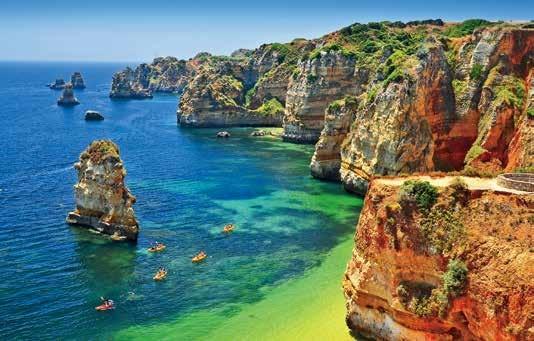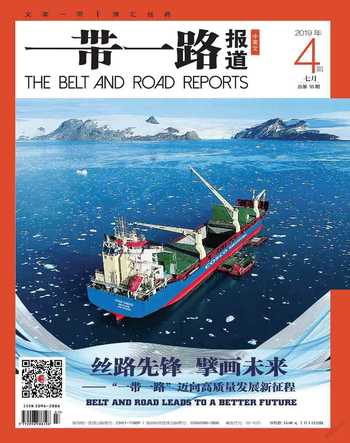发现旧大陆 发展新大陆
尊敬的葡萄牙总统先生、尊敬的里斯本工商界的各位贵宾、女生们、先生们,这是我第二次来到里斯本!上次是作为旅游者,特意去了天涯海角,领略了大航海时代的壮观。
今天,中国提出“一带一路”倡议,并不是重复欧洲历史上陆权与海权的此消彼长,而是要实现旧大陆——欧亚大陆的陆海联通, 同时发展新大陆——让非洲、拉美等前欧洲殖民地实现工业化,拿习近平主席2017年5月在首届“一带一路”国际合作高峰论坛主旨演讲中的话来说,就是“设施联通是合作发展的基础。要着力推动陆上、海上、天上、网上四位一体的联通,聚焦关键通道、关键城市、 关键项目,联结陆上公路、铁路道路网络和海上港口网络。”

天下大势,分久必合,合久必分。欧洲的哲学是分,尤其是葡萄牙向东、西班牙向西,将地球瓜分为东半球、西半球,1494年6月7 日在教皇见证下签订《托尔德西里亚斯条约》。
中国的哲学是合。欧亚大陆时代:马/骆驼+帆船时代(17世纪前);海权时代:蒸汽时代(18世纪)——铁路时代(19世纪)——飞机时代(20世纪);陆海联通、万物互联时代:高铁时代(21世纪)。
因此,“一带一路”必须以21世纪开创人类新文明角度理解,并非中国新丝绸之路复兴古丝绸之路,而是开创新型全球化。“一带一路”可以用中国三句文学语言来理解:
——天堑变通途
“一带一路”的精神就是互联互通,而这是基于中国自秦始皇实现中国大一统的基础,实现了国内的互联互通,由内及外,由近及远,实现世界的互联互通。
中国不到十年时间建起了四纵四横的高铁网,占世界高铁的六成以上,正在拓展为八纵八横的人类有史以来最发达的交通网络。
中国通过“一带一路”帮助邻国实现他们的便捷交通、快速回家的梦想,并沿着交通线路进行产业布局和开发。中国拓展了市场,沿线国家实现了发展,这就是共赢。
——天涯若比邻
万里茶道(茶马古道):陆路为Cha,海路为Tea,见证了古丝绸之路以茶会友的传统。
今天,中國的许多邻国人认为他们与中国的心理距离比与欧美的还远。改变地理距离与心理距离的反差,“一带一路”提出“民心相通”理念,可以说是在欧洲一体化四大流通自由基础上的创造性转化、创新性发展。
——天涯咫尺
志合者,不以山海为远。“一带一路”源于古丝路又超越之,基于欧亚大陆又不局限于欧亚大陆。美国学者写了本书《超级版图》 ( Connectography)提出“互联互通决定21世纪竞争力”,与我的《世界是通的》有异曲同工之妙。
互联互通之妙,在近代法德竞技中也得到了鲜明体现:自从步入铁路时代,德国统一之后,法国就一直被德国打败,原因从德国互联互通的铁路网就不难找到原因,法国的铁路网不仅没有德国密集,更重要的是条条铁路通巴黎。
这种情形就在非洲上演:法语区非洲国家,还要去巴黎转机才能到邻国!
西方殖民以来,非洲国家间联系少,都是与欧洲宗主国联系,到达邻居的航班要绕道巴黎!非洲内部贸易只占总对外贸易的10%-15%。有全球化但没有地区一体化(globalization without integration)!埃塞俄比亚产咖啡豆,但一般老百姓却喝不起咖啡,原因是没有咖啡加工业,要从欧洲进口咖啡制成品。于是出现“遍身罗绮者,不是养蚕人”。
殖民以来,非洲成为西方资源、原材料市场,联系是单向的、分割的(欧洲一体化并未把宗主国在非洲的殖民体系一体化,非洲市场仍被西方殖民者分割),内容也是贸易—援助,形式单一。
“一带一路”推行“三网一化”,要让非洲市场以点带线,以线带片,从基础设施(港区铁路贸五位一体)互联互通着手,帮助非洲获得内生式发展动力,形成经济发展带,实现工业化和农业现代化,共同脱贫致富。
“一带一路”的原则是三共,共商:群策群力;共建:众人拾柴火焰高;共享:有福同享,这也可用文学语言描述:聚是一团火,散是满天星;独行快,众行远。
总之,“一带一路”的文学解读就是过去-现在-未来三句话:
过去:我们共享一个月亮:观念(海上升明月,天涯共此时)。
现在:我们只有一个地球:开创21世纪可持续新文明(天涯咫尺,天堑变通途)。
未来:我们共探一个宇宙:全球公域之治(天涯所盼,走出历史)。
葡萄牙开启了人类大航海时代的壮举。今天,葡萄牙完全可以在实现中欧陆海联通,进而推进世界互联互通,建设人类命运共同体中,实现新的辉煌!
谢谢大家!
Distinguished President of Portugal, guests of the business community of Lisbon, ladies and gentlemen, good morning/afternoon/evening! It is the second time that I have come to Lisbon. Last time I came here as a tourist. I visited Cabo da Roca, the remotest corner of Continental Europe, where I appreciated the splendor of “the Age of Discovery” .
Today, by proposing the Belt and Road Initiative, China does not mean to follow the old path of Europe, namely the shift between land power and sea power. Rather, it seeks to connect Eurasia, the old continent, via land and sea, and develop new continents, i.e., realizing industrialization in Africa, Latin America, and other former European colonies. As what President Xi Jinping said in his keynote speech at the First Belt and Road Forum for International Cooperation in May 2017, “Infrastructure connectivity is the foundation of development through cooperation. We should promote land, maritime, air and cyberspace connectivity, concentrate our efforts on key passageways, cities and projects and connect networks of highways, railways and sea ports.”
A Chinese saying goes like this: domains under heaven, after a long period of division, tend to unite; after a long period of union, tend to divide. This has been so since antiquity. For Europe, the basic concept is division: Portugal and Spain divided the earth into the Eastern Hemisphere and the Western Hemisphere through the signing of the Treaty of Tordesillas under the witness of pope on June 7, 1494.
But China’s concept is unity. The era of Eurasia: an age of horse/camel+sailboat (before the 17th century); the age of sea power: the Age of Steam (the 18th century)-railway age (the 19th century)-the age of airplane (the 20th century); an era of land and sea connection, and “Internet of Everything”: the age of high-speed railway (the 21st century).
Therefore, we have to approach the Belt and Road from the perspective of ushering in a new civilization of mankind in the 21st century, and embarking on a new type of globalization, rather than using the new Silk Road to revive the old Silk Road. The Belt and Road can be summarized as:
——Changing the invincible water into a thoroughfare.
The essence of the Belt and Road is connectivity, which tracks back to the great unity of the First Qin Emperor. With domestic connectivity as the foundation, efforts will be made to realize the connectivity of the whole world.
In China, a crisscross high-speed railway network, accounting for over 60% of high-speed railway in the world, was built within a short span of less than 10 years. Greater efforts are being made to expand it into the most advanced transportation network throughout history.
By developing the Belt and Road, China is helping neighboring countries to realize the dream of convenient transport, and developing industries along traffic lines. A win-win scenario is realized when China expands the market and countries along the route gain better development.
——A bosom friend afar brings distance near.
Ten thousand miles of tea route (ancient tea horse road): the tea trade was a tradition along the ancient Silk Road. Delivered by land, it was welcomed along the route as Cha; shipped through the sea, it arrived the west Europe with a new name Tea.
Today, many people in China’s neighboring countries feel Europe and America as closer friends than China. To narrow geographical and psychological distance, the concept of “people-to-people bond” was included into the Belt and Road Initiative. It represents an innovative conversion and development based on the free flow of people, goods, capital, and service of European integration.
——A connected world.
Nothing, not even mountains and oceans, can separate people with shared goals and vision. The Belt and Road originated from ancient Silk Road and transcends it, and is based on Eurasia but not limited to it. An American scholar wrote a book Connectography, in which he proposed the idea“Connectivity determines competitiveness in the 21st century”. The idea echoes with what I put forth in my book The World Is Connected.
The wonder of connectivity can be seen in the competition of France and Germany in modern times: since entering the railway age and the unification of Germany, France has been outshone by Germany. A look at railway network of the two countries offers us the obvious reason: in Germany, railways are connected; while in France, the railway network is not as dense as that of Germany, and what’s more, each railway leads to Paris.
The problem is seen in Africa: for people of African countries in French-speaking region, they have to transfer flights in Paris before arriving in neighboring countries.
Since being colonized by the West, African countries have witnessed little connection with each other. All countries connect with their European suzerains, and flights bound to their neighboring countries have to make a detour in Paris. Internal trade in Africa only accounts for 10%-15% of their total foreign trade. So it is globalization without integration. Ethiopia grows coffee bean, yet ordinary Ethiopian cannot afford to drinking coffee. That is because the country has no coffee processing industry and has to import finished coffee products from Europe. Hence the phenomenon, “Of those who are dressed in fine silk, none has ever raised a silkworm.”
Since the start of colonialism, Africa was divided into resources and raw materials markets of the West, featuring one-way and fragmented connection(European integration has not integrated African colonial system and African market is still divided by western colonists). Between Africa and the west, the connection is purely trade and assistance.

In Africa, the development of the Belt and Road seeks to build three networks (high-speed railway, highway, and regional aviation) and industrialize infrastructure. Efforts will be made to connect African market through infrastructure, and integrate ports, regions, railway, highway, and trade, so as to form economic development belts, realize industrialization, agricultural modernization, and poverty alleviation.
The principles of the Belt and Road: consultation for collective wisdom, co-building with joint efforts, and sharing. That can be described as: when we are together, we look like a ball of fire; when we are scattered, we are stars interspersing in the sky; if you want to go fast, walk alone; and if you want to go far, walk together.
In a word, the Belt and Road can be summarized with such a literature interpretation:
In the past: we shared the same moon: concept (As the bright moon shines over the sea, from far away you share this moment with me).
Present: we have only one earth: building a sustainable civilization of the 21st century (The world becomes smaller; changing the invincible water into a thoroughfare).
In the future: we will explore the same universe: the governance of global public domain (Shaking off the past).
In the past, Portugal opened the Age of Discovery. Today, Portugal can integrate China and Europe via land and sea, strive to realize connectivity of the whole world, build a community of shared future for mankind, and reap new glories.
Thank you!
(本文是2018年5月4日在葡萄牙里斯本俱乐部年会上的演讲,有删减)
(This is an abridged version of the speech delivered at the 3rd Lisbon Conference in Portugal on May 4, 2018

